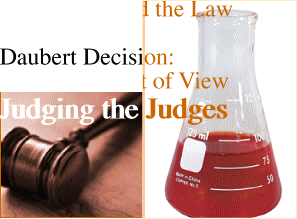 |
|||||||
Expertise |
||


Special Report
Judging the Judges
How well and consistently do judges carry out their 'gatekeeping' role? How well do they understand science? And is this court activity assessed in any way?
Weight of Evidence: How does science handle complex questions of causation and what is the court's reaction to this?
By Thomas F. Schrager, Ph.D.
Weight of Evidence (WOE) as described in Krimsky's article in the special seminar series of the American Journal of Public Health (AJPH) is something widely used both by scientists in evaluating data and in setting regulations and guidelines in the public policy sphere, and is widely understood but is hard to define. Why? Because it calls upon all of one's expertise, training and experience and it addresses all types of issues concerning data big and small. A definition would probably require pages. It is this very imprecision that causes problems in the courtroom: something that is not clearly defined can be defined any way one likes. And so the court tends to avoid weight of evidence testimony and opinions even though they underpin of scientific practice.
The court's approach to deconstruct evidence into separate studies and to look at the validity, relevance and strength of each one individually, makes a WOE analysis all but impossible. What effect does this have on courtroom scientific testimiony? In many instances it undermines it and weakens it to the point that causation testimoney becomes difficult at best or all but impossible at worst.
The argument has been made that weight of five pieces of weak data cannot be turned into a whole of strong data. That mistates the practice and point. 'Weight of Evidence' is somewhat of a misnomer; more accurately it's the fit of evidence that is key rather than its weight. It is how pieces of evidence fit together, complement one another, create a picture larger than themselves that is the determinant, rather than the weight. Weight goes more to a proper interpretation of the quality of each piece of evidence. A high quality piece of evidence has the potentional to add to a fit with other high quality data and/or to put into better context lower quality data. For example, as reported by, an epidemiological study of 300, 000, a clearly large study with presumably strong statistical power, showed no effect of benzene on ; however, human chromosomal analysis of those exposed showed a characteristic break only seen in those with .....
Epidemiological evidence is often viewed as the sin qua non of proof of human causation, but the problem with this approach is that a negative finding is not necessarily a finding of no connection but rather lack of power or some other flaw in the study. In many other instances, epidemiological data simply doesn't exist.
As stated elsewhere, the International Agency for Research on Cancer (IARC) and the U.S. National Toxicology Program (NTP) have identified compounds as human carcinogens (IARC) or as 'anticipated to be human carcinogens' (NTP) or 'probable human carcinogens' (IARC) based on less than sufficient human data but instead data in animal models, and through mechanistic studies showing similar mechanisms of action in both humans and the animal model.
(continued)
This approach and this type of evidence reflects a consensus view within the mainstream scientific community. 'Consensus' here means two different things: one, that the scientific community as a whole supports this approach and the use of this evidence in this way and do so not as the result of a vote, but due to a long process of testing, retesting, considering, hypothesizing and observing results of experiments; and two, the weight of evidence approach in which many types of evidence and studies are looked at together.
A single animal study may not be considered 'weak' or 'strong' but if it is well carried out and its results can be trusted, then in conjunction with mechanistic studies showing that the chemical is handled similarly in animals as in humans, that the same enzymes and repair proteins exist in both species and function in the same way, allows the animal data to be considered in a certain context.
Likewise, the consensus approach allows for the handling of a certain kind of data, as pointed out in a National Academies of Science report on Science and Law: there is evaluation of a single study and the data that follows, and the evaluation of a set of studies and all the data that follows from those studies. This is the weight of evidence approach, of fitting together many pieces of data, much as one would look at something from many different perspectives to get a fuller three dimensional 'picture' and to draw conclusions.
It's important that the court be educated on these issues, be reminded with examples of how the scientific community handles this information (IARC and NTP are good examples), so that the court can become more receptive to a WOE and consensus approach.